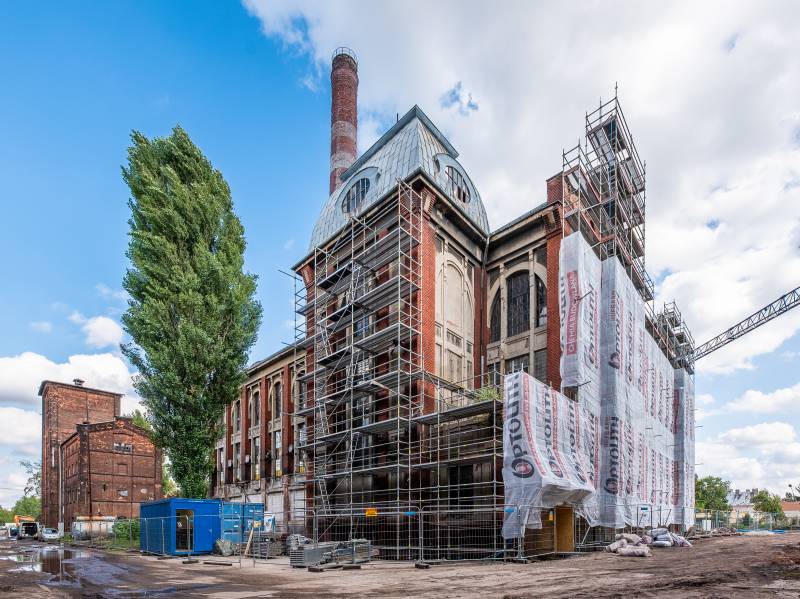

The pearl of Łódź Art Nouveau, a historic power plant located on the premises of Karol Scheibler’s former textile empire, is the heart of Fuzja - a city-forming project Echo Investment implements in Łódź. Thanks to the investor, the power plant will soon regain its former splendor and energy. The company has just started renovating the damaged facade.
“The historic power plant is something. It is a pearl not only of Łódź but also of European Art Nouveau architecture” says Waldemar Olbryk, the management board member at Echo Investment. “It was built with a dash one seldom see at industrial facilities, with the top quality materials used for final touches. To prevent further destruction of a building of such great historical value, we start to renovate its exterior. By the end of the year, we will finish working on the western facade, and next year we will deal with the eastern one, chimney and northern and southern walls. By December 2020, the power plant will regain its former beauty. What is essential, we want this place to be accessible to people, so we plan to give it an exhibition, entertainment, or gastronomy functions”adds Waldemar Olbryk.
The power plant is an example of the best industrial Art Nouveau not only in Poland but also in Europe. It was erected in 1910 based on the design of the Latvian engineer Alfred Frisch, who focused on modernity and then prevailing styles: Art. Nouveau and modernism. The building's structure is of reinforced concrete - it has been one of the first buildings in Łódź built this way. At the same time, it is the widest reinforced concrete ceiling built without any itermediate supports. The power plant facade was finished with contrasting materials - bright plaster and red clinker brick. Noteworthy are the soaring windows with geometric stained glass. The same attention to details can also be seen in the interiors, with the staircase lined with indigo Villeroy & Boch tiles and decor with a white Art Nouveau motif. A forged, cast-iron railing accompanies the stairs. The main walls of the hall are decorated with Indian yellow Art Nouveau tiles and the floor - monochrome tiles with a scroll motif. The building was a showcase of the Scheilbler empire and the new era of electrification. The power plant operated continuously until 2003. To this day, part of its technical equipment has been preserved, including the oldest turbine made by the German company AEG in 1935.
“The non-existent southern wall is a real challenge. Together with the conservatorand designers from the Medusa Group, we agreed not to rebuild it in its original shape. This way, we would only get a modern imitation of historical tissue. Instead, we decided to re-design it in a contemporary style, taking into account the primary divisions. The historical façade highlights the columns, the attic cornice, and the intermediate beam. The layout of the entire facade is vertical. The primary finishing material for the new southern facade will be Corten sheet metal. This noble material ages in a unique way – it gets covered with patina. Such a coating is initially orange-brown, and with time it acquires a darker shade, guaranteeing a unique and long-lasting effect without the need for conservation”says Waldemar Olbryk.
Fuzja, an urban project located at Tymienieckiego street in Łódź, will be an open part of the city, friendly to life, work and rest. It will consist of four residential buildings with over 600 apartments, as well as offices with a total area of about 40,000 sqm. The historic buildings will also have space dedicated for services, shops, and restaurants - a total of about 15,000 sqm. New city squares, shared spaces, and green areas will be created, occupying almost 4 hectares. Fuzja’s residents and users will be able to take advantage of numerous amenities, including car-sharing services, bike paths, bicycle service stations, parcel lockers, and electric chargers. All this will make Fuzja - a well-thought-out and a unique investment – an exceptional place on the map of Łódź, attractive to both residents and tourists.